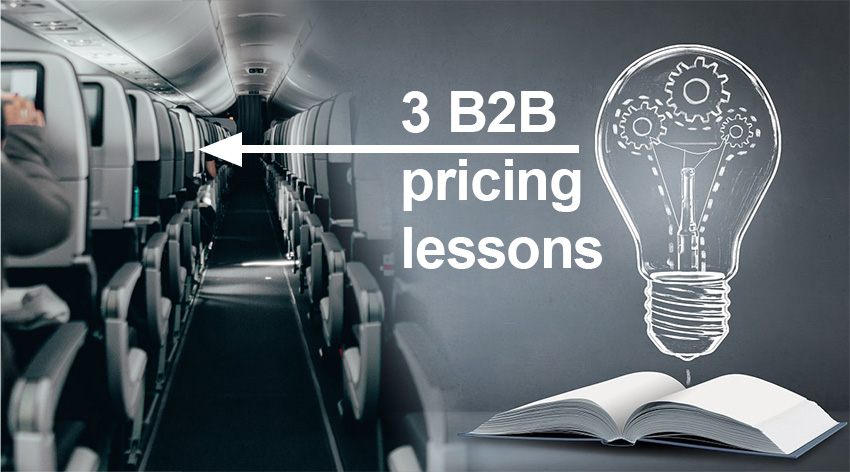3 Lessons Airlines can Learn from B2B Pricing Practices
I hope everyone had a Merry Christmas and are ready to welcome the exciting new year of 2024. I apologize for being a bit slow with my blog over the past couple of weeks, as this is the only time of the year when I have time to travel back to Taiwan to see friends and family.
As this is probably the last blog post of 2023, I often reflect upon the past year as quite a lot of things happened. It is often the case that I would give gratitude to all the amazing things that I’ve experienced over dinner with my wife. Although many of these are personal, a few observations of planetary scope deserve a mention.
- Certainly, 2023 is the year that AI awareness and interest became a global phenomenon
- 2023 is also a year where the world says goodbye to COVID
- As such, air travel (business or leisure) is back
Personally, I’ve lost ALL of my hotel and airline status during and after COVID, but looks like I will be getting them back with all the travel I did in 2023. Part of this is also instigated by the global interest in AI. However, even though travel is back, it came back slightly different. Because the pandemic does have some lasting effects, as people relocate and settle in new places, work-from-home becomes permanent for quite a few companies.
As airlines get back on their feet, they must look for every opportunity to drive demand and capture more bookings. And there is a lot that airlines can learn from the business-to-business (B2B) industry. B2Bs have traditionally operated successfully amidst high demand volatility under highly competitive markets. And airlines should embrace some of B2B’s demand forecasting and pricing best practices to secure the most market share.
Here are 3 lessons that airlines can take from the B2B industry to welcome the new challenges as travel returns.

Don’t Just Abandon History
Due to the high predictability of people’s travel behaviors before the pandemic, airlines have traditionally leveraged long history (i.e., seasonality) over many years to help forecast travel demand far out into the future (up to a year out). These reliable predictions enabled airlines to optimize and price their future fares, enabling consumers to book and pay for their flights up to a year in advance.
However, the pandemic has significantly disrupted this, and long-historical bookings are no longer a reliable predictor of far-out future travels. Remember, even though travel is back, it came back differently. So, airlines can’t use their historical seasonality in the same manner as before. This doesn’t, however, mean that airlines should abandon historical seasonality altogether.
B2B enterprises have always operated under demand uncertainties. The global supply chain has made the B2B market extremely competitive because buyers can find equivalent products at a comparable price and switch vendors easily. Therefore, B2B companies use a shorter relevant history (typically a few months or weeks) and forecast a shorter window (a few months) into the future.
Requiring a smaller amount of data, this approach enables B2Bs to do these short forecasts quickly, more reliably, and more frequently. Consequently, B2B businesses can track the dynamic market condition more effectively. As more passengers are booking closer to departure due to travel uncertainties, this practice could help airlines capture more bookings, and recoup revenues faster. But airlines will have to be more agile to take advantage of this.
Diverse Data is Helpful
Traditionally, airline revenue management (RM) systems have used four major inputs to help them forecast demand and optimize prices. These include:
- Historical bookings (i.e., seasonality)
- Current bookings on hand
- Real-time availability
- Holidays and special events
With ongoing volatility across air travel, airlines have been forced to use a shorter booking history to make near-term forecasts. This reduces the data volume that airlines can use to forecast future travel demand, and in turn, the confidence of these forecasts. To improve the accuracy and confidence of demand forecasting, airlines can learn from B2B and retail businesses by incorporating a greater variety of data from different sources into their forecasting engine.
In both B2B and retail (where demand volatility is the norm), when businesses can’t use more of the same data (i.e., longer history), they usually leverage more different kinds of data. It’s fairly common for retail marketers to use 10 or 15 different data sources to help them forecast demand. Everything from historical purchases, web searches, website clickstreams, competitor prices, to social media mentions and impressions, is fair game.
Some additional data sources that could potentially improve airline demand forecasting include flight search data, events data, weather, fuel price index, and even economic indicators. Our own research at PROS found promising results when using both flight search data and events data to augment conventional booking forecasts. Our research found flight search data could improve demand forecasting accuracy by up to 40 percent at an aggregate level. Although this result is highly inflated due to the during-pandemic test period and the small sample of manually selected 35 international markets, it suggests that shopping data may be a strong predictor of future bookings.
Consider Willingness-to-Pay (WTP)
Most RM systems work by generating a bid price that represents the expected marginal opportunity costs of a seat under various availability conditions. Airlines use this as an effective control mechanism to close fare classes that are priced below the bid price. This makes perfect sense economically, since selling below the bid price means the airline would incur a higher opportunity cost than the sales price.
This, however, is a low-end control, and it’s most useful when the demand is high, and the airline is capacity constrained. However, conventional RM systems don’t have a high-end control mechanism, and it doesn’t tell the airline how high they can or should price a seat.
Whilst the demand for air travel has returned at an aggregate, the demand remains volatile due to many global-level disruptions. For some routes, the excess in capacity could drive the bid price down to zero. As we’ve learned through the pandemic, telling the airline not to sell a seat below $0 isn’t useful, since the airlines already knew this.
When demand is volatile, this is when a high-end control is crucial. This is accomplished by estimating the consumers’ willingness to pay (WTP) for a seat. Since most B2B transactions are negotiated based on business relationships and context, B2B pricing has always been predominantly determined by the buyers’ WTP. The state-of-the-art B2B pricing engines are combining transaction history with both product and customer attributes to predict the WTP price under different business scenarios.
Airlines could benefit tremendously by considering passengers’ WTP. By factoring WTP into their control mechanism, especially during demand disruptions, airlines can truly outperform their competitors.
What’s Next?
In comparison to other industries, airlines are in many ways ahead of the game, having leveraged predictive and prescriptive analytics for a long time. Whilst airline demand will continue to grow as the pandemic recedes and flight disruptions are resolved, demand will be different from before, with more volatility.
Airlines that can learn from B2B businesses that have operated successfully in current market conditions will be most equipped to handle these challenges. Moreover, those that can quickly adopt the AI technologies and pricing practices from B2B will have more tools to inform their revenue management, and they will acquire long-term competitive advantages in the market.
DISCLAIMER: The content of this article was first published by PhocusWire. Here is the latest revision and a current rendition of the raw manuscript submitted to the publisher. It differs from the originally published version.


